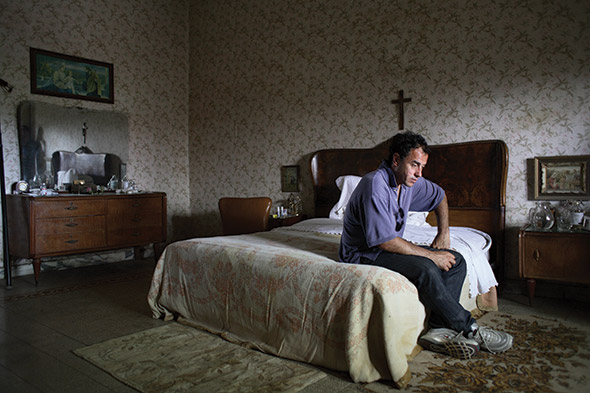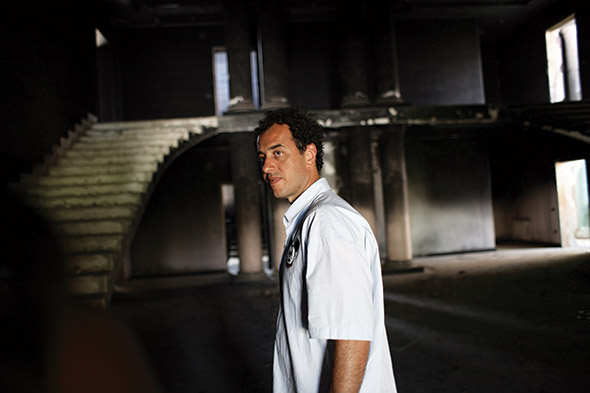Married to the Mob: Italian filmmaker Matteo Garrone shares his experience with making his harrowing yet brilliant film Gomorrah, as well as subverting the mafia genre
Text by Adam Keleman

“At the beginning, I was really worried to work in the ‘real’ territory,” filmmaker Matteo Garrone states, cautiously. He’s referring to the Italian region inhabited by the real-life crime organization, Camorra, depicted in his new film Gomorrah. “I relied on cinema being very important to people. The Camorra wanted us to make a movie about them. And so I realized the film with the help of the people that live there.”
Garrone may have been somewhat hesitant about making a film about the largest crime syndicate in Italian history, but this adaptation, sharing the same title as the Roberto Saviano novel upon which it’s based, is a story worth telling. “We wanted to make this movie from inside the Camorra—from the bottom, not from the top,” Garrone says. In his efforts, Garrone has crafted a masterful statement about the chaotic underbelly of society and crime—without judgment.
Painting at an early age in Rome, where he grew up, Garrone was raised in an artistic milieu. “My mother is a photographer… and my father is a theater critic,” he says, noting that his stepfather is in fact the director of photography on Gomorrah. These painterly leanings were definitely his focus growing up but, “cinema is a figurative art,” he says. “From painting to cinema, the step was very lateral. When I was 26, I shot a movie produced by myself, to see if I was good enough… when I started to make cinema, I stopped to paint.” Fortunately, for us, he found his way back to the camera.

After making several feature films and winning numerous awards for his work, it was the novel, Gomorrah, that would put Garrone on the international stage as a filmmaker. “It was Summer 2006. I read the book and found it very powerful,” he recalls. “And visually, I thought the images were very strong, and characters that were very new. Saviano wrote the book from inside the Camorra.” It was Saviano’s portrayal of this world from the inside out that grabbed Garrone’s attention. “When we started to work on the screenplay, we focused on five stories… the book had hundreds.” He continues, citing Roberto Rossellini’s war film Paisa as a reference point for his construction of Gomorrah’s multi-character narrative. “We wanted to make a movie that talked about problems that were universal and global—like environment, drugs, violence, black market and war.” These ideas may have been lofty, but Garrone’s desire to focus on individuals within the Camorra system unraveled a sprawling web of complex moments and conflicted characters illustrated in the film.
Essentially, Gomorrah is a cinematic palette of skin-and-bone characters, thriving in a world that conspires to tear them apart. Garrone had no intention of painting these lives in the clichés of the gangster genre. “It was very important not to glamorize the characters,” Garrone says, adamantly. “It is not a critique of the masterpieces of Coppola or Scorsese—which I admire—it’s just a different point of view from a different country.” To deviate from the mafia framework, Garrone utilized the inhabitants of the Camorra territory, located in Naples and Caserta, to legitimize the film’s conceits. From their insight, Garrone could thoroughly sculpt the realism he was after. “In that territory, someone every day is being killed by a club,” he laments. “I remember there were always a lot of people [from the territory] behind the monitor while I was shooting. It was very important—their reaction to what we were doing.” He even employed actors plucked straight from location to add another layer of authenticity to the piece. These casting choices may have been suspiciously ideal, as some of these men had recently been arrested for alleged dealings with the Camorra.
Despite the scandalous headlines, Garrone was truly after actors who could bring these unorthodox characters to life. Producing an honest work straight from the belly of the beast, Garrone’s world reflects layers of gray, not just classifying these characters as black or white. He explains, “We wanted to tell the contradiction that many people that lived in the territory were conditioned by the system. But try to describe that territory and show the gray zone, [whether it be] good or bad, legal or illegal.”
The film’s reception has been remarkable, and its celebrated premiere at the 2008 Cannes Film Festival has given the film a far-reaching distribution platform. “It was the first important test for the movie,” he says. “Thanks to the [Grand] Prize, we sold the movie in many countries. Cannes very much helped the movie to be seen in the world.” Garrone has another chance to reach larger audiences, as the film was nominated for Best Foreign Language Film at the Golden Globes (beat out for the title by Waltz With Bashir) and is slated for a February 13 release in the States. In conclusion, Garrone shares what he hopes the Yanks will experience upon viewing his mafioso masterpiece: “When I go to cinema, for me, it’s important to have emotion, to be surprised by a reality I couldn’t expect, to be surprised visually, and to see characters that are original, different from other movies. I hope the American audience will be surprised.”

